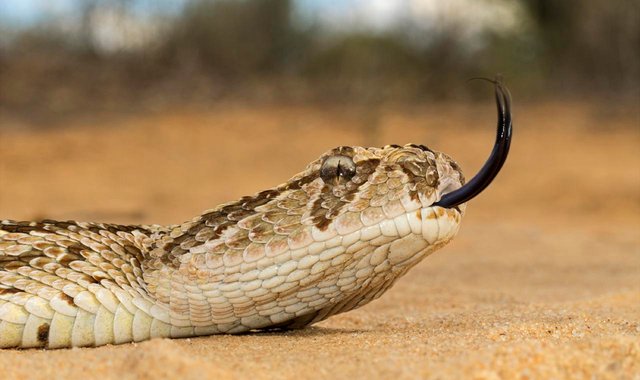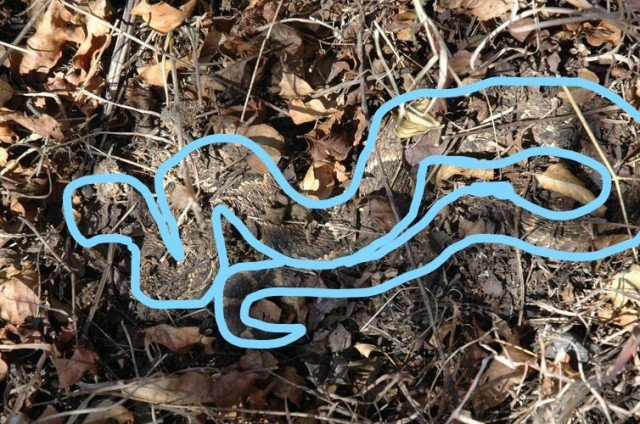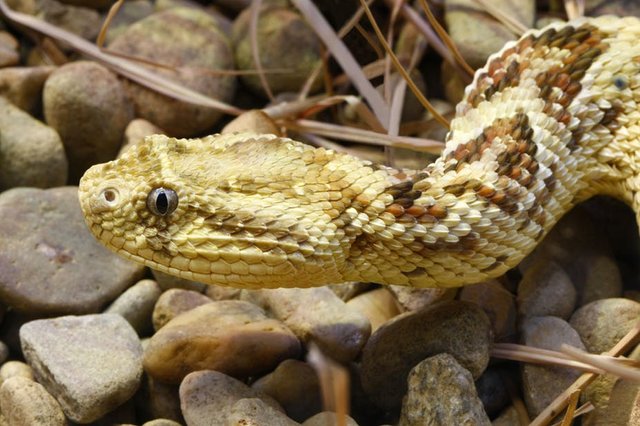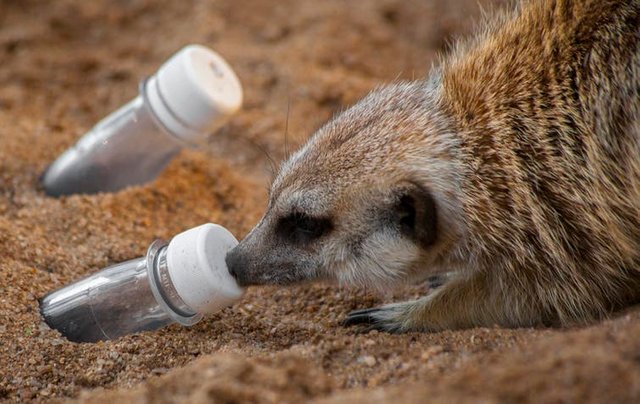The Puff Adder: Taking Camouflage to a Whole New Level
The puff adder (Bitis arietans) is a venomous pit viper species native to much of the African continent; along with being one of the most widespread snakes of Africa, it is also counted among the most venomous species, and is responsible for more deaths on the continent than any other snake species. The adder, like all pit vipers, is an ambush hunter, lying in wait for possibly days at a time waiting for prey to come just close enough to bite and envenomate.
However, unlike many species of snakes, the puff adder spends nearly all of its life above ground, and only very rarely takes refuge in burrows or beneath cover such as rocks. While the adder may be a fearsome animal to humans, it is actually prey for a large number of animals; biologists have documented 42 species that prey on the puff adder, and have found that in years of extreme predation, adult adder mortality rates can approach 50% of the population! Lying in ambush leaves the snake vulnerable to any predators that may spot it, and its body is too squat for it to effectively escape by fleeing. Instead, the snake must rely on hiding in plain sight using the ultimate form of camouflage, and a secret stealth technique that has remained a mystery until now.
When approached by a predator, biologists observed that the adders remained motionless, choosing to commit to their camouflage even at the risk of being caught. Even in instances where wild dogs, meerkats and mongooses were observed walking directly over the snake, the adder exhibited no response. More interestingly, however, was the lack of response from these animals walking over them; they showed no awareness of the snakes' presence. This is bizarre because these animals (and up to 15 of the adder's predators) hunt primarily based on scent, which should bypass the effective visual camouflage of the snake. This rose a new question for biologists: are puff adders escaping scent-oriented predators by hiding or reducing their own scent?
To test the theory, a study was conducted using two of the adders typical predators: dogs and meercats. These animals were trained for "scent-matching", meaning the animals had to match pairs of scents to each other among a line-up of scent options.
Six snake species were tested in total against these scent-based predators. In 100 scent-matching trials, the dogs and meerkats were able to identify the snakes with 90% accuracy...except for one. In every trial, the puff adder sample stumped the dog and meerkat teams, and they were unable to match the two samples. The biologist concluded that the puff adder is the first known terrestrial vertebrate species to employ "chemical crypsis"; it simply does not have a detectable scent.
<iframe width="600" height="355" src="
This chemical crypsis is the result of an evolutionary arms race. Having evolved alongside these predators that have developed better and better olfactory senses, the snake has had to evolved its own countermeasures to avoid extinction. While this is a world's first finding, the biologists remain confident that this ability is likely common in the animal kingdom. Animals that ambush their prey and experience a high mortality rate from predators, such as the puff adder, and species that reside in exposed locations, such as ground-nesting birds or young deer fawns, would be far more likely to survive if they were able to mask their odor or remain completely scentless. The only reason we are just discovering this now, it because our research is biased towards our own primary sense: our vision. Using this research, the teams hopes others will launch their own investigations into other occurrences of chemical crypsis. However, one question still remains for the research team: how is the puff adder able to employ such an effective means of camouflage?
Video Link: 1
Article Link: https://theconversation.com/






That is fascinating about the scent masking! I wonder how long it took for this evolution to occur. And I wonder why is hasn't happened in other pit vipers or adders?
We don't know yet whether or not this occurs in other pit viper species. While it has only been confirmed in the puff adder, biologists speculate this may be common throughout the animal kingdom.
Again fascinating information about snakes. We have a similar type of snake in Australia called the Death Adder. I hope you cover some of our snakes.
BTW, you might find this photo interesting. It was taken by Queensland police out on patrol in a regional area last week. The python in the photo is estimated to be between 60 - 70 years old and approximately 5m long.
It's funny that you mention the death adder...I had to go back and edit the post because I kept writing death adder instead of puff adder!
I do cover a few Australian snakes now and then (I've hit on the tiger a couple times and your copperhead). Since it's winter here, I focus a little more on articles like these since there aren't many herps out and about!
A friend of mine is involved in native animal rescue and he specialises in snakes. He tells me that two of the most common venomous snakes we have in the North, the King Brown and the Red Belly Black are mortal enemies. The Brown has a bad reputation because they are very aggressive, where as the Red Belly is quite shy. However as snakes are very territorial, the Red Bellies will kill and eat the Browns. Thus the Red Bellies are kind of welcome because they keep the aggressive Brown snakes away.
Haha we have some similar species of snakes with a similar dislike for one another. It is always fun when people ask me how to keep venomous snakes away from their homes and I tell them that keeping other less-dangerous snakes around is the best method xD
My aforementioned snake rescue friend also has unpopular advice for people. Leave the venomous snakes where they are. University studies have show that by the time you first see the snake around your house, it would have already seen you some 40,000 times. It knows your routines and does its best to keep out of your way. The problems arise when you remove it from its territory, a new one will move in, that does not know your routines and you might give each other a nasty surprise. Snakes do not like nasty surprises, and thus react defensively.
His summation is, unless you are small enough to eat, or an attractive snake it would like to breed with, they don't want to know about you and would rather keep out of your way.
Of course, if they become too close and personal and move into your house or shed, then, they have to be removed. That's where he comes in.
Whoa. They didn't kill it, did they?
No, the police didn't hurt the snake or touch it. They just took photos. =)
Of course the only chance the snake has, is not to be found. I dont think any kind of snake is able to outrun a dog or a meercat over a meaningful distance. So the only option for the snake is to remain motionless and trust in the excellent camouflage pattern it has.
And on not to be smelly, of course. As far as I know, this is not completly unknown in the animal kingdom.
Little deer babies for example, also dont have a smell. And they apply the same kind of strategy as the snake: laying still and rely on the camouflage pattern, no matter what. Even if you stand right in front of them, they dont try to run away.
Hey buddy, glad to see you're still creating these posts! Hope to take part in a contest soon lol
I really hope to do one soon! I've been trying to find the time to hold one but with house renovations to do I haven't had much time to sit by the computer! I'll definitely make an effort to hold some shortly!
Interesting. Puffies are very chilled out snakes when you come across them in the wild in my experience. I did some work on a nocturnal species at one point and encountered these guys a few times and in each case nearly stepped on them before realizing they were there.
The scent aspect does shed some interesting light on an encounter that has perplexed me for a while: I saw a bat eared fox approach a puffy and he seemed very confused by its presence. Kept sniffing it as if to try and confirm what it was, even after the puffy started 'puffing.' Cool article, thanks :)
Saya sangat menyukai posting anda... 👉👌👍👋👏👏👏👏👏
Hewan yang menyergap mangsa mereka dan mengalami tingkat kematian yang tinggi dari predator, seperti puff adder, dan spesies yang berada di lokasi yang terbuka, seperti burung bersarang atau rusa muda, akan jauh lebih mungkin bertahan jika mereka mampu.
di Afrika Memang sangat di kenal dengan ular yang sangat berbisa juga dihitung di antara spesies yang paling berbisa, dan bertanggung jawab atas lebih banyak kematian di benua ini daripada spesies ular lainnya.
Excellent article @herpetology guy! I had never even heard of chemical crypsis. Great to find another herpetologist here! My father lost his right index finger to a puffadder bite in kenya back in the 60s.